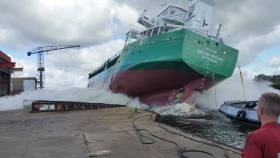Displaying items by tag: Arklow Venture
Record Breaking Year At Irish Sea Port of Silloth
#ports - According to Associated British Ports (ABP) which operates the Port of Silloth on the Irish Sea, has celebrated a record-breaking year in 2018 by handling the highest cargo volumes since 2015.
This year the north-west English port handled a total of around 156,000 tonnes of cargo, representing nearly a 20% growth in tonnage volumes since 2017.
In addition, in December, the vessel ‘Blue Six’ (pictured above) carried more than 3,700 tonnes of French wheat became the fifth largest delivery to enter the port since official records began in the 19th century. The wheat was processed at Carr’s Flour Mill, a thriving business and important local employer, founded more than 180 years ago.
The top spot for Silloth’s largest cargo delivery is still held by the ‘Arklow Venture’ (see launch) which transported over 4,200 tonnes of bulk fertiliser from Antwerp to Silloth in March 2014.
Carl Bevan, ABP Divisional Port Manager – North West, said: “We are pleased to report that the Port of Silloth has had an excellent year, handling 58 piloted ships and exceeding expectations thanks to the positive performance of our customers and colleagues.”
“We also opened our new ground-mounted solar farm in May 2018 which allows ABP Port of Silloth to generate more electricity than it consumes with all surplus green electricity being exported to the National Grid.”
Dutch Yard's 'Bloomsday' Launch of Arklow Venture
#Launch – Once again it was a Dutch yard that launched a cargoship for Arklow Shipping and that took place on this Bloomsday morning, writes Jehan Ashmore.
Arklow Venture with yard no. 727 represents the seventh so far of 10 ‘V’ class ordered to the Royal Bodewes yard from their own designed Eco-Traders.
The launch of Arklow Venture brings to more than 50 ships of the joint Irish and Dutch flagged fleet. They comprise of short-sea dry cargoships to bulk-carriers.
Arklow Venture has a 87m long hull that features a straight-stem bow. The design reduces wave resistance and so saves on fuel consumption adding to greater efficiencies.
As previously reported, a sister Arklow Vanguard was delivered last month having also been completed at the yard located in Hoogezand near Groningen.
The V class are all Dutch flagged and are managed by Arklow Shipping Nederland B.V. Among the typical cargoes theses sisters ships will transport will be grain, animal feed and steel rails.

























































